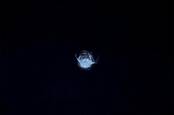This article is more than 1 year old
Cosmic prang probe: Euro space boffins to smash sats, virtually
ESA wants to solve crucial riddle: What really happens when accidents occur in orbit?
The European Space Agency is launching a new research project to study satellite collisions in space.
“We want to understand what happens when two satellites collide,” said Tiziana Cardone, an ESA structural engineer leading the project, on Tuesday. “Up until now a lot of assumptions have been made about how the very high collision energy would dissipate, but we don’t have a solid understanding of the physics involved.”
Space junk is a real concern for future spaceflight missions as the surrounding area outside of Earth gets increasingly crowded. Scientists have only seen four events when satellites have crashed into one another so far and these collisions, plus 60 years of orbital launches, have left more than 500,000 bits of floating debris clogging up the space around Earth.
As this piles up, it increases the chances of space trash crashing into spacecraft. These collisions will likely leave a trail of rubble, adding to even more junk.
Potentially this could create a runaway chain reaction of collisions and debris, known as the Kessler effect, named after former NASA scientist Donald Kessler, that could destroying everything in near-Earth orbit and fragments whizzing around the planet at thousands of kilometers per hour destroying everything in their path.
The satellite collision occurred in 1991, when Russia’s Cosmos 1934 spacecraft was hit by a piece of older Cosmos 926 hardware. Five years later, the second incident was between France’s Cerise satellite and a chunk of the Ariane 4 rocket.
The third was in 2005, when a US satellite was struck by a scrap from a Chinese rocket and the fourth happened in 2009 between an Iridium satellite and Russia’s Cosmos-2251.
Obviously, blowing stuff in orbit is counterproductive so researchers will have to turn to studying simulations instead. These are being run by the Fraunhofer Institute for High-Speed Dynamics, a materials science laboratory in Germany, and the Center for Studies and Activities for Space at the University of Padua in Italy.
“Of the four known collisions, only one of them took place in the way we expected, with both satellites breaking up catastrophically, generating clouds of debris," said Holger Krag, a researcher at ESA’s Space Debris Office.
"The others were quite different, so there’s something missing from our picture. By running many different collision variants then we hope to understand what happened across the actual collisions, to help substantiate our modelling.”
Numerical simulations will model the spacecrafts as a “finite element mesh”, a common method used to build predictive simulations of objects under stresses and strains. The material is split into smaller parts called elements, which are converted into clouds of particles as the satellite breaks apart during the impact.
Another simulation method represents satellites as being made up of many multiple parts such as panels, propellant tanks, solar arrays and payload. During a collision, the physical links holding these parts together are broken and fragmented.
The researchers can use a library of previous crash events and data and modify them to track how satellites behave when they slam into one another. After these simulations, the researchers will turn to practical experiments to smash together 500 kg-scale satellites.
“We need to have this understanding because we are currently working on expensive debris mitigation strategies based on our understanding of debris behaviour. We’re projecting the evolution of the debris environment up to 200 years ahead,” Krag added. ®

